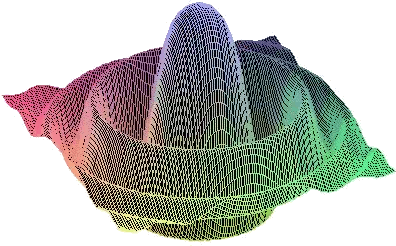Home Page of Roland Steinbauer
Project 12023
Links
Distributional Methods in Einstein's Theory of Gravitation
The field of research of the interdisciplinary project Distributional Methods in Einstein's Theory of Gravitation lies at the borderline between mathematics and physics. Its central theme is situated at the junction of the physical theory of general relativity and a comparatively recent branch of mathematics with the aim of initiating synergies between these fields.
Einstein's theory of general relativity describes the physics of space, time and gravitation. Amongst other things it predicts the existence of gravitational waves; their detection is one of the great challenges in the field of experimental physics of our days. The project at hand at first was concerned with the theoretical investigation of gravitational shock waves of a certain kind, which - vividly speaking - model a puls of radiation rushing by and for a very short time distorting the given geometry of space-time.
The mathematical field - the theory of nonlinear generalized functions - on the other hand provides a new method of predicting the behaviour of so-called singularities, e.g. shock-waves or very short impulses especially in nonlinear situations, i.e., when cause and effect are not proportional to each other. Such nonlinear situations are by no means exceptional, on the contrary, they represent the vast majority of real world processes. On the other hand they are clearly much harder to deal with than linear situations.
Now general relativity is an inherently nonlinear theory and the mathematical description of its singular solutions - which in many cases represent the most interesting physical phenomena such as, e.g., black holes - is extremely difficult. The distributional description of gravitational shock waves which was achieved in the course of the project constitutes the first link between the two fields.
This application to relativity imposed new requirements on the mathematical theory which in fact caused considerable repercurssions on the mathematical development itself. One of the fundamental principles of general relativity is coordinate-invariance: all laws of nature have to be formulated without reference to any special observer. The research group DiANA (Differential Algebras and Nonlinear Analysis, http://www.mat.unvie.ac.at/~diana) which was co-founded by some of the co-workers of the project was able to develop the mathematical method to a level where all results can be formulated independently of any special observer or - speaking more technically - can be given in a coordinate independent manner. Hence a geometrical theory of generalized functions has been created which in turn lends itself to a broad variety of further applications in a geometrical context.
In particular, in the course of the project the theory could be applied to provide a distributional description of black holes and to solve further concrete problems in connection with the description of singular space-time geometries of general relativity. Hence the first bridging between the physical theory and the mathematical method turned out to be just the beginning. The project succeeded in producing application-oriented and applicable fundamental research in the interdisciplinary borderland of mathematics and physics.

